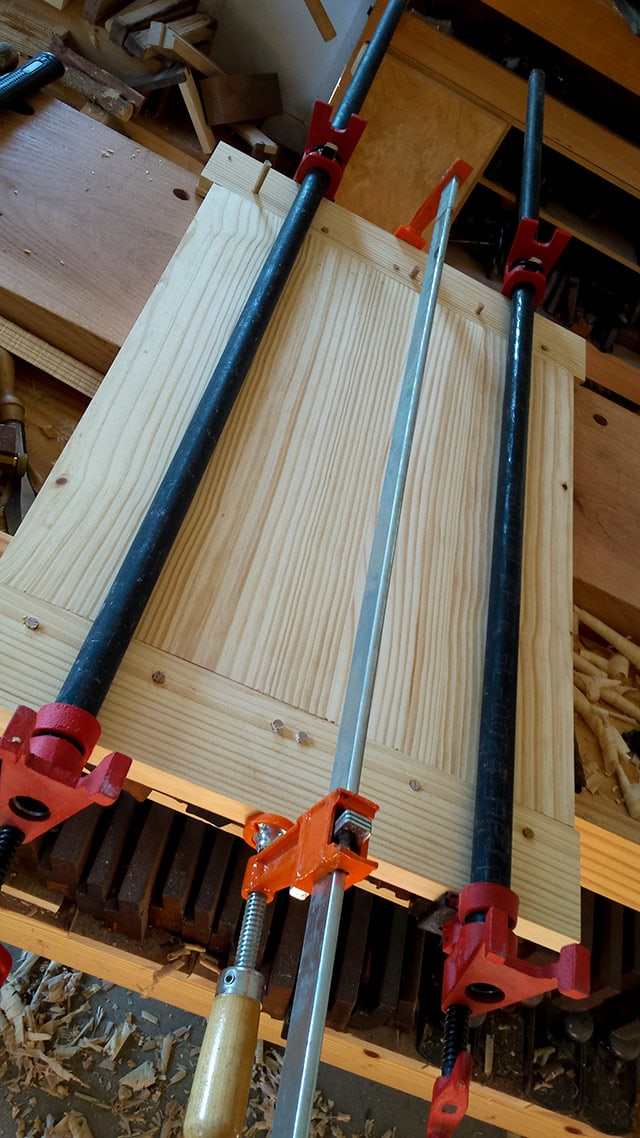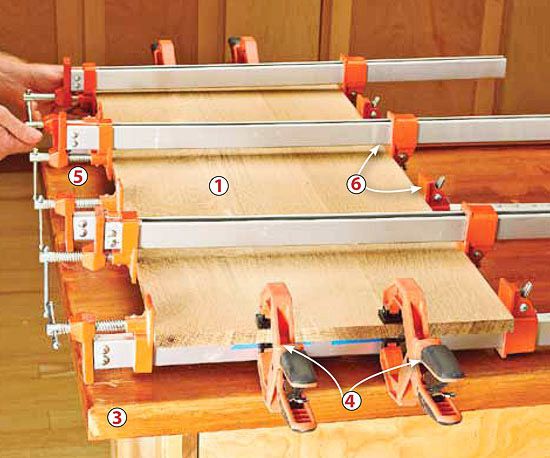Do you have to use clamps with wood glue? If you’ve ever tried woodworking or watched a DIY project, you may have come across this question. It’s a common query among beginners and even some experienced woodworkers. Today, we’re going to dive into this topic and discover whether clamps are essential when using wood glue.
Imagine this scenario: you have a piece of wood that needs to be joined together securely. You’ve got your trusty wood glue ready to go. But here’s the big question – do you need to grab some clamps as well? Well, it depends on various factors, such as the size and weight of the project, the strength of the wood glue you’re using, and the drying time.
Before we jump into the details, let’s address the elephant in the room. Yes, clamps can be extremely helpful when working with wood glue. They provide pressure and ensure a tight bond between the pieces of wood, enhancing the overall strength and durability of your project. However, clamps aren’t always necessary, especially for smaller and lighter objects.
Now that we’ve touched on the basics, let’s explore the topic in more depth and uncover when and why you should use clamps with wood glue. We’ll also discuss alternative methods that can achieve similar results without using clamps. So, whether you’re a woodworking enthusiast or just curious about the magical world of adhesives, this article is for you!

The Importance of Using Clamps with Wood Glue
Wood glue is a staple in woodworking projects, providing a strong bond that holds pieces together. However, when using wood glue, many people wonder whether they need to use clamps to secure the pieces while the glue dries. In this article, we will explore the reasons why using clamps with wood glue is crucial and how it can enhance the strength and durability of your woodworking projects.
1. Ensures Proper Alignment
Using clamps with wood glue ensures that the pieces being glued together are in proper alignment. When you apply glue to a joint and use clamps to hold the pieces together, it prevents any shifting or movement during the drying process. This is especially important for complex or intricate woodworking projects that require precise alignment. Clamps provide the necessary pressure to keep the pieces in position until the glue dries, resulting in a seamless and well-aligned joint.
Without clamps, the pieces may shift or move as the glue dries, resulting in misaligned joints and a weak bond. The glue needs sufficient time to set and form a strong bond between the wood fibers. By using clamps, you eliminate the risk of misalignment and ensure that the pieces stay in place until the glue cures.
Furthermore, clamps allow you to apply consistent pressure across the joint, ensuring an even bond. This is particularly important when working with irregularly shaped or uneven pieces of wood. The clamps distribute the pressure evenly, allowing the glue to spread and bond effectively.
2. Increases Strength and Durability
One of the primary reasons to use clamps with wood glue is to enhance the strength and durability of the joint. When wood glue is applied to a joint and clamps are used to hold the pieces together, the glue dries under pressure. This pressure forces the glue deep into the fibers of the wood, creating a strong bond that is difficult to break.
Without clamps, the bond between the pieces may not be as strong or durable. The glue will not have the necessary pressure to penetrate the wood fibers and create a secure bond. As a result, the joint may be weaker and more susceptible to failure over time, especially when subjected to stress or load-bearing situations.
Additionally, using clamps with wood glue ensures that the joint is fully sealed. The pressure applied by the clamps compresses the wood fibers, allowing the glue to fill any gaps and create a tight bond. This prevents moisture and air from entering the joint, reducing the risk of warping, rot, or decay.
3. Provides Time for the Glue to Cure
Another important reason to use clamps with wood glue is to allow sufficient time for the glue to cure. Wood glue typically requires a certain amount of drying time to achieve maximum strength. By using clamps, you can ensure that the pieces remain in position until the glue has fully dried and cured.
Attempting to hold the pieces together manually while the glue dries is not only inconvenient but also risky. Any movement or disturbance during the drying process can compromise the bond and weaken the joint. Clamps provide a reliable and secure method of holding the pieces in place, giving the glue the time it needs to cure properly.
Additionally, using clamps allows you to work on other aspects of your woodworking project while the glue dries. This saves you time and allows for a more efficient workflow, as you can proceed with other tasks without worrying about holding the pieces together manually.
Key Takeaways:
- Wood glue creates a strong bond between wood surfaces.
- Clamps help hold the pieces together while the glue dries.
- Using clamps ensures a tighter and more secure bond.
- Clamping prevents wood movement during the drying process.
- However, clamps may not always be necessary for small or light projects.
Frequently Asked Questions
Looking to understand more about using clamps with wood glue? Here are some commonly asked questions:
Can I use wood glue without clamps?
While clamps are not always necessary when using wood glue, they can greatly improve the quality of the bond. The purpose of clamps is to hold the pieces firmly together while the glue sets. This ensures even pressure distribution, minimizes movement, and allows the glue to dry properly. Without clamps, there’s a risk of the pieces shifting or separating, resulting in a weaker bond.
However, if you’re working with small, lightweight pieces or have different methods of securing the wood, such as screws or nails, clamps may not be required. It ultimately depends on the project and the type of wood you’re working with.
What should I consider when deciding whether to use clamps or not?
When determining whether to use clamps with wood glue, consider the size and weight of the project. Larger or heavier pieces will benefit from clamping, as they are more prone to movement during the drying process. Additionally, the type of wood being used also plays a role. Softer woods tend to compress more, which can affect the bond if not clamped properly.
Furthermore, consider the pressure required for a strong bond. If the surfaces being glued are uneven or don’t fit perfectly, clamping can help bring them together tightly. It’s also important to assess the drying time of the glue. Some wood glues set quickly, while others require more time before they fully cure. Clamps help maintain alignment and ensure the glue has enough time to dry thoroughly.
What types of clamps should I use with wood glue?
The type of clamp you choose depends on the size and shape of your project. For smaller pieces, spring clamps or bar clamps are excellent options. They are easy to use and provide a secure grip. Pipe clamps are useful for larger projects, as they can apply uniform pressure across a wide area. Parallel clamps are effective for wide surfaces like tabletops, ensuring even pressure distribution.
It’s also essential to consider the material of the clamps. Look for clamps with protective pads or covers to prevent them from damaging the wood’s surface. This is especially important when working with softwoods or finished pieces. Overall, select clamps that can provide enough pressure and stability for your specific project.
Do I need to keep the clamps on until the wood glue is completely dry?
The duration of clamping depends on the specific wood glue you’re using. Most wood glues recommend holding the pieces together under clamping pressure for at least 30 minutes to an hour. However, it’s best to follow the manufacturer’s instructions for the particular glue you have chosen. Some stronger wood glues might require a longer clamping time, so make sure to check the label.
Once the recommended clamping time has elapsed, it’s advisable to keep the wood clamped for a bit longer to allow the glue to fully cure. The complete drying time varies depending on factors such as temperature, humidity, and glue type. Generally, it’s recommended to leave the clamps on for a minimum of 24 hours to ensure a strong, durable bond.
Can I improvise if I don’t have clamps for wood glue?
If you find yourself without clamps for a woodworking project, there are some alternative methods you can try. One option is to wrap a sturdy, non-stretch material, such as rope or a ratchet strap, around the glued pieces and tighten it to apply pressure. Another method is to use heavy objects like books or weights to create pressure on the glued joint.
However, keep in mind that these improvised methods may not provide as even or strong a bond as clamps. They can also be more challenging to control, potentially resulting in misalignment or insufficient pressure. It’s always best to use proper clamps when using wood glue for the most reliable and high-quality results.

How to clamp wood without any clamps !
Summary
When using wood glue, clamps are not always necessary but can be helpful. Clamps provide extra pressure to ensure a strong bond between the pieces. If you don’t have clamps, you can use other methods like using heavy objects or weights to apply pressure. Just make sure to let the glue dry completely before removing any pressure.
